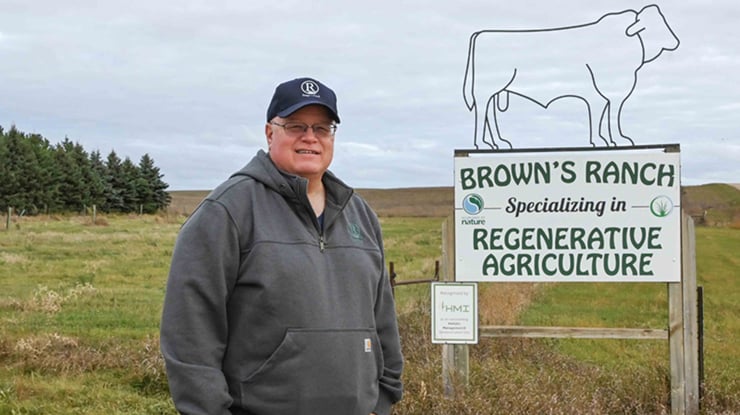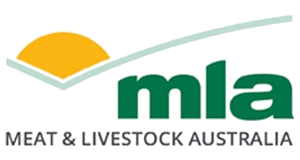Regenerative agriculture across continents: same principles, different systems
03 February 2025
 Gabe Brown
Gabe Brown
‘Browns Ranch’ near Bismarck, North Dakota, is almost at the centre of North America, just 200km south of the Canadian border. The 2,430ha property, characterised by rolling, rocky terrain, experiences long, cold winters and dry summers.
The ranch is home to renowned regenerative agriculture practitioner Gabe Brown and his family, who have been on the property since the 1980s. Gabe and his wife Shelly purchased the ranch from Shelly’s parents in 1991 and handed over the reins to their son seven years ago when Gabe started his consulting business, Understanding Ag.
The property, dominated by perennial pastures, produces a variety of crops and pasture-raised cattle, sheep, pigs and poultry, which are all marketed directly to consumers.
On the other side of the world, near Bathurst NSW, lies ‘Goonamurrah’, home to Ross and Dimity Thompson and their children. Ross and Dimity run a seedstock cattle operation, Millah Murrah Angus, on 951ha of undulating granite country with native and improved pastures and some fodder crops. They also have a 280ha holding on the edge of Bathurst and lease another 600ha located between the two properties.
While Bismarck may seem a world away from Bathurst, the land management principles used on these properties have a lot in common.
Adaptive grazing
For Gabe, the limited growing season in his region makes adaptive grazing practices critically important.
“We have a very limited growing season – we only have about 110 frost-free days each year,” Gabe said.
“We receive about 80% of our moisture in a six-to-eight-week window, in May and June. That moisture has to grow enough forage to last the whole year.
“To be able to graze your animals year-round means that you have to be very good at adaptive grazing, moving the animals frequently for ample rest and recovery periods for the forage.
“During the growing season, the animals are moved every day. They’re moved according to the conditions, how much forage you have, what your resource concerns are, and what you’re trying to improve – and that changes all the time, which is why we call it adaptive grazing,” he said.
At Goonamurrah, the Thompsons have refined their grazing management practices significantly over the last five years.
Operating a stud, it’s not easy to destock and restock when conditions get dry, so the Thompsons have invested in substantial wire and water infrastructure to allow for implementation of time-controlled grazing principles.
Under this system, livestock are moved regularly between paddocks. This allows for intensive grazing for short periods, with long periods of rest for seeds to germinate and pastures to recover. Paddocks are fenced according to land capabilities, which gives them the option to reduce the grazing pressure on sensitive areas.
The preservation of groundcover through this strategy is important for the soil stability, soil health, water holding capacity and overall resilience of these areas.
A silver lining
Gabe took his first steps into regenerative agriculture in 1993 when he moved to a no-till cropping system. Shortly afterwards, Gabe and Shelly experienced four consecutive years of crop failure due to hailstorms and dry conditions.
What might have been the final straw for some was just the beginning for Gabe, who noticed the benefits of changing his management strategies. With little cashflow and no choice but to limit his inputs during this time, Gabe added legumes to the crop rotation to reduce nitrogen requirements. To diversify his business, he also integrated livestock onto the cropland, grazing the cover crops to turn losses into dollars.
Gabe’s learnings, shared through his book Dirt to Soil, have been an inspiration to Ross in the way he manages his property.
“It’s not something we can change overnight, but Gabe’s approach is pragmatic – that’s what I like about it,” Ross said.
Ross is also trialling multi-species pastures and crops, controlling weeds, reducing inputs (where possible) and using rest periods (or, in highly sensitive areas, stock exclusion) to restore landscape health.
It all starts with the soil
For Gabe, who has been refining these grazing practices for over 35 years, observations of the landscape that help to inform the cropping or grazing rotations have become second nature.
“Every time I walk into an arable field or a paddock, I’m running through the principles in my mind,” he said.
“First thing, we have a shovel, and we check soil aggregation. Then, how much bare soil is there? If we see bare soil, we’re behind the game already. Is water infiltrating the soil or is it running off?
“Then, how much diversity do we have? Do we need more diversity? We can stimulate the latent seedbank by using animals as a tool.
“It’s all based on observation and what we’re seeing,” he said.
Over time, the combination of management and ecological changes has resulted in significant improvements to soil organic matter, soil structure and water infiltration.
“My fields, which in 1991 could only infiltrate a half an inch per hour because of the loss of soil aggregates due to tillage, can now infiltrate over 32 inches per hour because they are well aggregated,” Gabe said.
“By regenerating the health of our soil, which is the foundation of all terrestrial life, we can sequester more carbon, improve water and air quality, improve biodiversity and restore key ecosystem functions.”
Landing down under
Gabe will be coming to Australia to share his insights as part of the 2025 Wilmot Field Day.
For Gabe, it doesn’t matter what system you run or where you’re based, the principles of regenerative agriculture are the same. In his consulting business he works with primary producers from Ireland to Mexico who have been able to improve farm productivity by focusing on the health of the landscape.
“Nature is going to bat last every time. Why fight it? That’s what I learned from years of hail and drought – we need to work with nature rather than against it,” he says.
“Regenerative agriculture is common ground for common good.”


